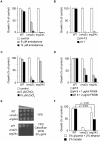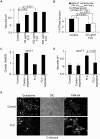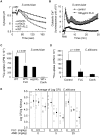Requirement for ergosterol in V-ATPase function underlies antifungal activity of azole drugs
- PMID: 20532216
- PMCID: PMC2880581
- DOI: 10.1371/journal.ppat.1000939
Requirement for ergosterol in V-ATPase function underlies antifungal activity of azole drugs
Abstract
Ergosterol is an important constituent of fungal membranes. Azoles inhibit ergosterol biosynthesis, although the cellular basis for their antifungal activity is not understood. We used multiple approaches to demonstrate a critical requirement for ergosterol in vacuolar H(+)-ATPase function, which is known to be essential for fungal virulence. Ergosterol biosynthesis mutants of S. cerevisiae failed to acidify the vacuole and exhibited multiple vma(-) phenotypes. Extraction of ergosterol from vacuolar membranes also inactivated V-ATPase without disrupting membrane association of its subdomains. In both S. cerevisiae and the fungal pathogen C. albicans, fluconazole impaired vacuolar acidification, whereas concomitant ergosterol feeding restored V-ATPase function and cell growth. Furthermore, fluconazole exacerbated cytosolic Ca(2+) and H(+) surges triggered by the antimicrobial agent amiodarone, and impaired Ca(2+) sequestration in purified vacuolar vesicles. These findings provide a mechanistic basis for the synergy between azoles and amiodarone observed in vitro. Moreover, we show the clinical potential of this synergy in treatment of systemic fungal infections using a murine model of Candidiasis. In summary, we demonstrate a new regulatory component in fungal V-ATPase function, a novel role for ergosterol in vacuolar ion homeostasis, a plausible cellular mechanism for azole toxicity in fungi, and preliminary in vivo evidence for synergism between two antifungal agents. New insights into the cellular basis of azole toxicity in fungi may broaden therapeutic regimens for patient populations afflicted with systemic fungal infections.
Conflict of interest statement
The authors have declared that no competing interests exist.
Figures






Similar articles
-
Vacuolar proton-translocating ATPase is required for antifungal resistance and virulence of Candida glabrata.PLoS One. 2019 Jan 23;14(1):e0210883. doi: 10.1371/journal.pone.0210883. eCollection 2019. PLoS One. 2019. PMID: 30673768 Free PMC article.
-
Beyond ergosterol: linking pH to antifungal mechanisms.Virulence. 2010 Nov-Dec;1(6):551-4. doi: 10.4161/viru.1.6.13802. Epub 2010 Nov 1. Virulence. 2010. PMID: 21178501 Review.
-
Mechanism of the synergistic effect of amiodarone and fluconazole in Candida albicans.Antimicrob Agents Chemother. 2010 May;54(5):1753-61. doi: 10.1128/AAC.01728-09. Epub 2010 Mar 1. Antimicrob Agents Chemother. 2010. PMID: 20194694 Free PMC article.
-
Essential role for vacuolar acidification in Candida albicans virulence.J Biol Chem. 2013 Sep 6;288(36):26256-26264. doi: 10.1074/jbc.M113.494815. Epub 2013 Jul 24. J Biol Chem. 2013. PMID: 23884420 Free PMC article.
-
The V-ATPase as a target for antifungal drugs.Curr Protein Pept Sci. 2012 Mar;13(2):134-40. doi: 10.2174/138920312800493205. Curr Protein Pept Sci. 2012. PMID: 22264127 Review.
Cited by
-
Trafficking through the late endosome significantly impacts Candida albicans tolerance of the azole antifungals.Antimicrob Agents Chemother. 2015 Apr;59(4):2410-20. doi: 10.1128/AAC.04239-14. Epub 2015 Feb 9. Antimicrob Agents Chemother. 2015. PMID: 25666149 Free PMC article.
-
Inhibitors of V-ATPase proton transport reveal uncoupling functions of tether linking cytosolic and membrane domains of V0 subunit a (Vph1p).J Biol Chem. 2012 Mar 23;287(13):10236-10250. doi: 10.1074/jbc.M111.321133. Epub 2012 Jan 3. J Biol Chem. 2012. PMID: 22215674 Free PMC article.
-
Potential of Yeasts as Biocontrol Agents of the Phytopathogen Causing Cacao Witches' Broom Disease: Is Microbial Warfare a Solution?Front Microbiol. 2019 Jul 31;10:1766. doi: 10.3389/fmicb.2019.01766. eCollection 2019. Front Microbiol. 2019. PMID: 31417539 Free PMC article. Review.
-
Inositol Phosphoryl Transferase, Ipt1, Is a Critical Determinant of Azole Resistance and Virulence Phenotypes in Candida glabrata.J Fungi (Basel). 2022 Jun 21;8(7):651. doi: 10.3390/jof8070651. J Fungi (Basel). 2022. PMID: 35887407 Free PMC article.
-
Structural comparison of the vacuolar and Golgi V-ATPases from Saccharomyces cerevisiae.Proc Natl Acad Sci U S A. 2019 Apr 9;116(15):7272-7277. doi: 10.1073/pnas.1814818116. Epub 2019 Mar 25. Proc Natl Acad Sci U S A. 2019. PMID: 30910982 Free PMC article.
References
-
- Corti M, Palmero D, Eiguchi K. Respiratory infections in immunocompromised patients. Curr Opin Pulm Med. 2009;15:209–217. - PubMed
-
- Nucci M, Anaissie E. Fungal infections in hematopoietic stem cell transplantation and solid-organ transplantation–focus on aspergillosis. Clin Chest Med. 2009;30:295–306, vii. - PubMed
-
- Ryder NS. Effect of allylamine antimycotic agents on fungal sterol biosynthesis measured by sterol side-chain methylation. J Gen Microbiol. 1985;131:1595–1602. - PubMed
Publication types
MeSH terms
Substances
Grants and funding
LinkOut - more resources
Full Text Sources
Other Literature Sources
Molecular Biology Databases
Miscellaneous

